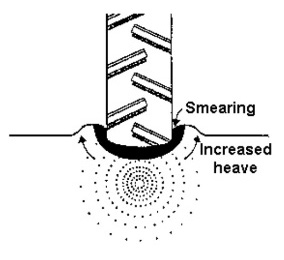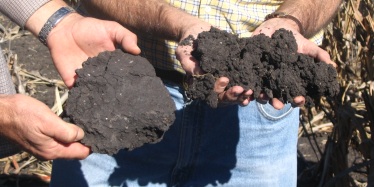Soil compaction
Good soil structure is important for the movement of water, gases and roots, which are all critical for a healthy soil. Compacted soils lack good soil structure as the air spaces that are essential in the movement of water, gases and plant roots are compressed.
Some soils have natural compacted layers which limit water entry, cause waterlogging and restrict plant growth. However continual ploughing at the same depth and heavy machinery traffic on wet soils can produce similar compacted layers.
Soil compaction can have an impact over a range of soils and climatic zones and can affect different industries, e.g. cropping, grazing and forestry.
Contributing factors
Factors that contribute to soil compaction include:
- the introduction of heavier machinery—heavier harvesters and haul-out bins have resulted in soils being subjected to greater loads
- frequent cultivation—this can result in plough pan formation, which is a hard or cemented layer of soil at the plough depth
- tillage when the soil is wet—the soil is more plastic when wet and therefore more susceptible to shearing and compression.
Effects

Clayey and silty soils are most susceptible to compaction because their particles hold more water for longer than sands or loams. As a result, clay soils remain in a plastic state, sometimes for the whole year, which means they will compress and shear when a load is applied to them.
Soil compaction can lead to:
- poor root growth—which reduces crop yield through poor water and nutrient uptake
- difficulties with soil cultivation and seedbed preparation
- a decrease in water entering the soil either as rain or irrigation
- a decline in soil structural stability
- a decline in fertiliser efficiency—as the large blocks of compacted soil provide few surfaces to retain and release fertiliser for crop growth
- a soil that requires more horsepower (and fuel) to cultivate—planting implements are less effective in compacted soil and poor germination is the result.
Evidence
Symptoms of soil compaction to look for on the soil surface:
- increased soil cloddiness
- surface clods that resist breaking down after rain or cultivation
- water ponding in tracks and headlands
- wheel tracks with a smeared appearance
- poor crop establishment in wheel tracks
- crop lodging, uneven plant growth and uneven ripening of the crop.
Symptoms to look for under the soil surface (use a shovel, clear back the loose topsoil and dig into the subsoil):
- a hard zone below the depth of cultivation (note that moist soil will be soft, though still compacted)
- soil remains in hard clods when you try to break it apart
- soil appears to have no structure
- flat, dull faces on soil peds
- distorted crop root systems (referred to as right angle disease).
Avoiding and managing soil compaction
A number of ways to minimise and manage soil compaction include:
- reducing the frequency of tillage—preferably by adopting a zero tillage system
- avoiding traffic and tillage when the soil is moist or wet—planting and weed control are 2 high-risk times as they usually follow good rainfall
- using the plastic limit test (if a 3mm diameter rod of a clay soil can be rolled out, then the soil is too wet for cultivation)
- reducing the compacted area by confining as many tillage and traffic operations to the same wheel tracks—a practice known as controlled traffic farming or tramline farming
- using large diameter, narrower tyres, which compact less area than small wide tyres or dual tyres
- using flotation low pressure tyres on all equipment, especially tractors, harvesters and haul out vehicles (if narrow tyres aren't feasible)
- restricting field bins and trucks to the edge of the paddock during harvest times
- encouraging organic matter build up—pasture rotation is recommended.
The most important factor determining the extent and severity of soil compaction is the moisture content at the time a load is applied.
Restoring damaged areas
Options for repairing a compacted soil can be biological or mechanical or both.
While clay soils are most susceptible to compaction, many have an in-built mechanism to repair structure degradation. They swell and shrink on wetting and drying, which causes cracking and breaks up the compacted soil.
Crop roots create soil pores and promote the formation of cracks in cracking soils. This biological ripping is a risk-free form of repairing soil compaction. The best response is gained by rotating crops or growing break crops to give different rooting patterns.

Cultivation
Cultivation when the soil is dry will hasten the natural breakdown of clods. This tillage needs to be shallow so that deeper (and usually wetter) soil is not compacted. Before starting, check the soil moisture profile to at least cultivation depth to ensure the soil is dry and that it will fracture rather than smear.
Ripping
Deep ripping should only be used as a last resort. Ripping moist to wet soil will cause further smearing and compaction. If the soil is dry enough to deep rip, the paddock should be cultivated first to leave some loose soil on the surface. This makes subsequent tillage operations more comfortable for the operator and helps restore the seedbed to a reasonable tilth quicker.


